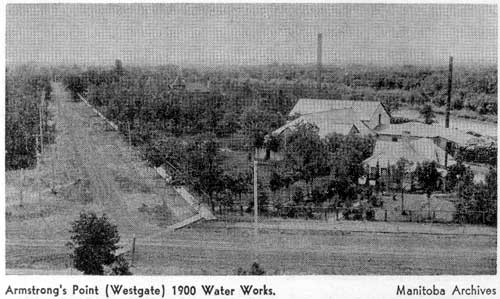Manitoba Pageant, Spring 1966, Volume 11, Number 3
|
From the Centurion, March 1966
In Winnipeg, Gordon Bell high school's history club is working for posterity as well as for itself. "What's past is prologue," Shakespeare said in The Tempest, and the students have found the application.
All their digging is leading to Canada's Centennial.

Armstrong's Point [West Gate], 1900 Water Works
Source: Archives of Manitoba
The seed of the project was sown by Mrs. Alice Brown and her junior history club some years ago. As a class project she got her students working on a segment of local history - the history of the district in which the school is located. The district was known as Mulvey in 1895; Nina was the street called Sherbrook now and Boundary was the name of the present Maryland - for it was literally the boundary of Winnipeg before the 1881-82 boom.
With maps before them, pointers in hand, and microphones draped around their necks, the youngsters performed with the aplomb of seasoned lecturers when they put on a demonstration recently at a regular meeting of the Manitoba Historical Society. Some of the society's members declared it to be "the best program we've ever had."
This year Mrs. Brown is president of Manitoba's historical society. Her students are now in high school. Their teacher at Gordon Bell is William G. Speechly, an enthusiastic historian with a private research project of his own - discovering the names of the de Meurons regiment Swiss who came with Lord Selkirk to Red River.
Carl Gow, who was principal of Gordon Bell till last June, called a meeting of his staff "when Centennial projects were being announced right and left ... to see what we might do." Mr. Speechly's history club, it was agreed, had put on a fine program; could not this be the basis of a record to deposit in the school library?
Now the project has become more than that: It is the nucleus of an archives.
Letters and old books have been collected from friends. Marguerite Gomez Fonseca Drummond, the daughter of W. G. Fonseca, a Point Douglas merchant who arrived here from St. Paul in 1860, gave the school an old city map. It has been framed and is now hanging in the school's hallway.
George McPhillips' Land Titles record, from 1881 to 1908, has been presented to the school. Its corduroy covers are frayed, its brown leather corners are flaking, but the copperplate script, beginning with the first 50 lots registered, is cleary legible. This huge tome now rests on a shelf in Classroom 204.
When documents to which the school could not obtain ownership were consulted, the students learned to purchase photostatas. They kept an eye on the newspapers for old timers' stories. Thus one student discovered with sudden pride, "Why, I lived right next door to Mrs. Elizabeth Green, granddaughter of 1815 Selkirk Settlers"
So the map of the district grew as the data accumulated. Printed on durable architects' drawing linen, in black and red India ink, it rolls up as neatly as a window blind. In use, it unrolls to hang from a classroom hook.
"Maryland Place is the name Hugh Sutherland gave his home, a landmark where Maryland bridge is now," contributed Mr. Speechly. "His bride came from Maryland. James Mulligan's house was on Broadway Place, on the west side of Gordon Bell. It was demolished to make a parking lot for teachers' cars."
The students have gathered other fascinating information. For example, one of the streets in the area is Garfield. It was named for the American president assassinated in 1881. Winnipeg newspapers printed so much about him, in the three months he lingered after his gunshot wound, that the students coined a word to cover the story - Garfieldia.
"The problem," said Mr. Speechly, "is always preservation." He pointed to a plan for a wall display case with glass fronts. It would cost $85. But, he said, "If we had a manual training class in school, I'm sure they (the students) could make it."
Is there a student, adept at cabinet work who would like to make a case for Canada?
Page revised: 18 July 2009